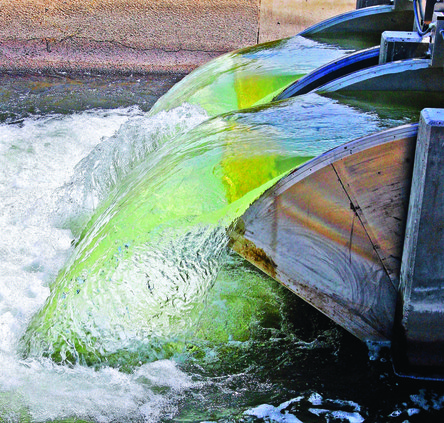South San Joaquin Irrigation District is suing the state in a bid to avoid a curtailment order from creating severe water shortages in 2022 for 200,000 Manteca, Lathrop, and Tracy residents and growers farming nearly 55,000 acres
SSJID, along with Oakdale Irrigation District, over a century ago secured first-in-line rights under state law for the initial 600,000 acre feet of annual water runoff in the Stanislaus River Basin.
A curtailment order issued Aug. 20 by the State Water Resources Control Board is essentially seizing the water the SSJID and OID legally own and prevents the agencies from diverting and storing Stanislaus River runoff in Donnells, Beardsley, New Melones and Tulloch Reservoirs.
The pre-1914 adjudicated water rights the two districts purchased, developed, and hold under California law means they legally have first right to the water.
“Concerns about next year’s water are developing now; we want to make sure we’re in a good position,” said Peter Rietkerk, SSJID’s general manager. “No one knows – and the state won’t say – how and when the decision will be made to lift the order.”
California is suffering from a second straight year of drought, which is affecting water supplies across the state. OID and SSJID customers fared better than most this year because of the Districts’ investments in efficient water management practices; farmers received full allocations, unlike those in other areas. But because of the state’s curtailment order, there is no telling what may happen next year if rain and snowfall are well below average for a third year in a row.
The SSID and OID have joined in a lawsuit challenging the State Water Resources Control Board’s authority to prevent the two water agencies from diverting and storing Stanislaus River runoff.
The state water board, in an emergency drought order issued Aug. 20, declared that OID, SSJID and 4,500 other water rights holders in California must immediately stop diverting water due to unprecedented drought conditions.
Both the SSJID and OID have the ability to use water previously stored behind those reservoirs and anticipate no immediate impacts to its agricultural and municipal customers.
The order also affects the Turlock and Modesto Irrigation Districts and the City and County of San Francisco, which have historic water rights to the Tuolumne River and store water behind Don Pedro Dam. Together, the four water agencies and San Francisco form what is known as the San Joaquin Tributaries Association.
The SJTA filed the lawsuit against the water board Thursday morning in Fresno Superior Court.
The state’s curtailment order is open-ended – meaning there is no specific date indicated when the irrigation districts may again begin storing water in reservoirs. The water board said the curtailments are necessary to keep salt water from building up in the Delta, to protect fish and to maintain drinking water supplies for cities.
The lawsuit contends the state violated the Districts’ due process rights and could impact the historic water rights held by SJTA members by not specifying when the curtailment order ends.
Runoff in the Stanislaus River watershed this year was about 350,000 acre-feet – well below the historic average of about 1 million acre-feet into New Melones Reservoir, making 2021 the third-driest year on record going back nearly 100 years ago. The problem is compounded by the fact that 2020 was the ninth-driest year ever recorded.
No two back-to-back years in any previous drought have been drier.
New Melones, managed by the federal Bureau of Reclamation, is the state’s fourth-largest reservoir, with a capacity of 2.4 million acre-feet. Thursday, it held about 899,000 acre-feet – about 37% of total capacity and only 65% of what it typically has in early September.
The two districts remain gravely concerned over the way the Bureau has managed New Melones water this summer.
From late June through mid-August, the Bureau increased flows in the Stanislaus River from 350 cubic feet per second to 1,500 cfs. The extra water ended up in the Delta and then the ocean. It was intended to make up for what was not being released at Shasta and Oroville Reservoirs because state and federal water officials said they wanted to retain cold water in those two lakes to release this fall to help protect spawning salmon on the Sacramento River and its tributaries.
“This year, the Stanislaus River has been a lifeline to the rest of the state,” Rietkerk said. “But for an already oversubscribed river system, how can the Stanislaus sustain our Districts, the communities we serve and the needs of the rest of the state? Our Districts and our partners in the SJTA often have no other recourse other than to file these lawsuits and fight for our communities.”





